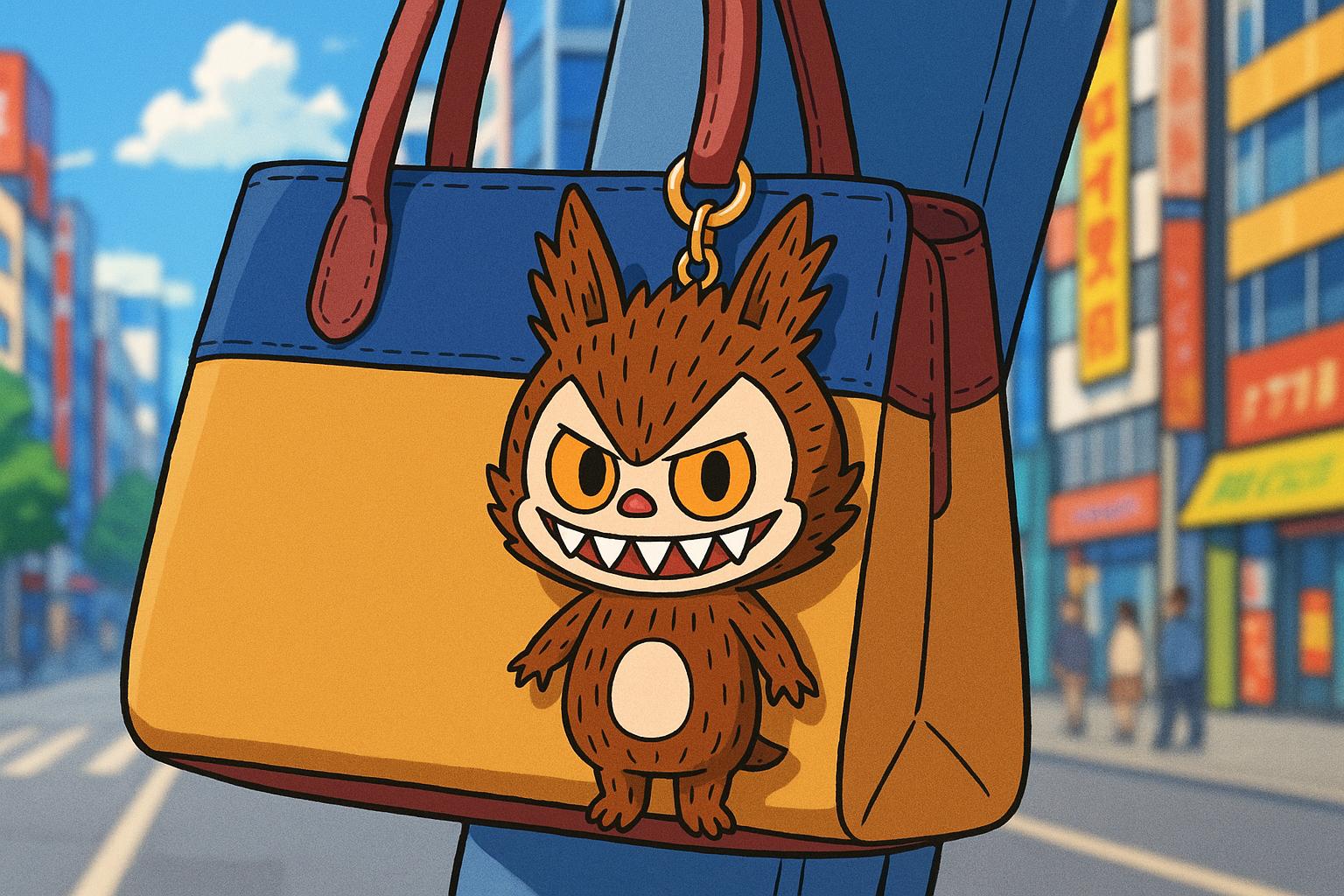The Labubu doll craze has ignited a frenzy among UK collectors, culminating in Pop Mart pausing in-store sales amid chaotic scenes in London. These whimsical yet edgy toys, beloved by celebrities and fashion houses alike, have become coveted status symbols in a booming adult collectibles market.
When 26-year-old healthcare consultant Michelle Keller unwrapped her latest find, a chestnut-furred Labubu doll, it was clear she had hit the jackpot. After navigating the frenzied crowds of central London and braving long queues, she successfully acquired a “rare special” Labubu, a whimsical yet slightly sinister creature that has captured the hearts of many. With its fluffy exterior, pronounced gnashers, and spiky ears, it evokes a nostalgic mix of childhood legends and pop culture—think a blend between a creature from Where the Wild Things Are and an unsettling Teletubby.
Keller, like many other enthusiasts, has found herself in the midst of an exhilarating hunt for these dolls, the latest in a long lineage of collectable characters from Asia, which includes beloved icons like Hello Kitty and Sonny Angel. The dolls, part of a collection known as The Monsters, were brought to life by Hong Kong illustrator Kasing Lung and have cultivated a dedicated following since their launch in 2019. Keller recounts her experience at the Pop Mart store in Soho, filled with tension as rival collectors scrambled for their own Labubu treasures, affirming that “it’s like a lottery.” Her newfound prize hangs from her handbag, a badge of honour within a thriving subculture defined by playful aesthetics.
Recently, Pop Mart, the exclusive global distributor of Labubus, announced it would temporarily halt in-person sales in the UK due to the chaos surrounding their popularity. Customers have reportedly camped outside stores, eager to snag the limited-edition figures, leading to serious safety concerns. With prices for these collectibles starting at £17.50, the rare dolls can fetch up to £1,500 online, making them a desired target for resellers. As Keller puts it, the competitive environment has prompted her to be more cautious with her prized possessions, opting to keep her rare Labubu at home, rather than risk theft.
While the phenomenon appears recent in the UK, Labubus have rapidly morphed into status symbols among young women, similar to last year’s craze for colourful Stanley cups. The trend speaks to a broader cultural narrative wherein displaying such trinkets indicates a certain level of cultural awareness and social connectivity. Despite the apparent superficiality of collecting quirky dolls, many participants find genuine connections through shared interests. The aesthetic is a reflection of a consumer culture increasingly centred around unique and relatable experiences.
Celebrity endorsements have been pivotal in propelling Labubu dolls into the limelight. Rihanna was spotted with her lychee berry Labubu on a Louis Vuitton bag, while Dua Lipa shared her own with her Hermès Birkin, further cementing the doll’s status as a fashionable accessory. K-Pop star Lisa from Blackpink has also joined the ranks, showcasing her Labubu collection, which has sparked immense interest among her fans. In a market where adults—often dubbed “kidults”—are projected to spend £1 out of every £3 on toys, the appeal of such collectibles continues to grow. The toys-for-adults market in the UK alone is valued at £1 billion, a reflection of shifting consumer habits where nostalgia meets luxury.
Adding to this dynamic, luxury fashion houses are adopting the trend, with designs featuring plushie-like accessories proliferating on runways and in boutiques. Miu Miu included bag charms in its latest collections, while Danish label (di)vision showcased plushie-covered coats at Copenhagen Fashion Week. This confluence of high fashion and childhood nostalgia illustrates how the accessorisation trend has transcended age demographics, with women—and men—seeking to personalise their belongings in ways that express their individuality.
The evolution of these playful accessories often draws parallels with historical trends, most notably Jane Birkin’s artistic flair for decorating her Hermès bags in the Eighties. Amanda Marcuson, founder of Bag Crap, underscores the creative potential behind these charms, noting that they allow for personal expression and foster community connections. This unique interplay can disarm perceptions, shifting how high-end luxury items are viewed. Instead of solely representing opulence, a Labubu charm can introduce an element of humour and relatability.
Notably, the appeal of Labubus lies partly in their non-conventional “cuteness.” While mainstream cute characters like Jellycats dominate the market, the sharp features and quirky aesthetics of Labubus resonate with those seeking something more stimulating. Joshua Dale, a professor of “cute studies,” asserts that this departure from traditional cuteness offers a fresh perspective on affection and interaction with playthings, particularly in a world filled with stress.
Interestingly, the perception of Labubus may differ across cultural boundaries. In Japan, the trend has taken hold not only among women but men as well, reflecting a more accepting atmosphere for such expressions. In contrast, Keller experiences skepticism on her daily commutes in London, where her furry companion often draws mixed reactions. However, she remains undeterred, eagerly planning to showcase her treasured Labubu in her new workplace, confident that the charm will eventually win over her colleagues.
The Labubu phenomenon encapsulates a shift in the realm of collectables, where personal connections and cultural expressions intertwine within a vibrant community. Beneath the playful exterior lies a landscape of shared experiences and mutual understanding, providing a space for joy in an increasingly complex world. As Keller and others weave their narratives around these lovable yet bizarre characters, they reaffirm that even in a culture driven by aesthetics, the heart of the trend resides in connection.
Reference Map:
- Paragraph 1 – [1], [2]
- Paragraph 2 – [1], [2], [3]
- Paragraph 3 – [2], [5]
- Paragraph 4 – [6], [7]
- Paragraph 5 – [1], [4]
- Paragraph 6 – [1], [2], [3]
- Paragraph 7 – [3], [4]
- Paragraph 8 – [1], [7]
- Paragraph 9 – [2], [3]
- Paragraph 10 – [1], [2]
- Paragraph 11 – [3], [5]
Source: Noah Wire Services
- https://www.independent.co.uk/life-style/labubu-dolls-uk-pop-mart-collectors-b2756716.html – Please view link – unable to able to access data
- https://www.independent.co.uk/life-style/labubu-dolls-uk-pop-mart-collectors-b2756716.html – An article from The Independent discussing the surge in popularity of Labubu dolls in the UK. It highlights the experiences of collectors like Michelle Keller, who faced long queues and competition to obtain rare Labubu dolls. The piece also touches upon the cultural significance of these collectibles, their blind box sales model, and the influence of celebrity endorsements, including Rihanna and Dua Lipa, in driving demand. Additionally, it addresses the challenges retailers face due to the craze, including safety concerns and store closures.
- https://www.thetoychronicle.com/news/pop-mart-available-in-the-uk-with-the-toy-chronicle/ – An article from The Toy Chronicle announcing the availability of Pop Mart products, including Labubu dolls, in the UK. The piece details the limited stock of various Labubu collections, emphasizing their exclusivity and appeal to collectors. It provides information on pricing and availability, noting that most items are in-hand and ready to ship immediately. The article highlights the growing interest in designer toys and the expansion of Pop Mart’s presence in the UK market.
- https://www.etsy.com/shop/LabubuQueens – A UK-based Etsy shop named LabubuQueens specializing in authentic, rare, and exclusive Labubu figures and collectibles. The shop offers a variety of Labubu items, including blind boxes and special editions. It provides details on pricing, availability, and shipping options within the UK. The shop’s announcement highlights regular new arrivals and the commitment to offering unique Labubu products to enthusiasts.
- https://labubu-uk.com/ – A UK-based online store dedicated to Labubu collectibles, offering a range of plush toys and accessories. The site features exclusive UK drops, blind boxes, and free shipping across the UK. It showcases popular Labubu designs and provides information on pricing and availability. The store emphasizes its connection to celebrity endorsements, including Olivia Attwood and Lisa from Blackpink, to attract fans and collectors.
- https://en.wikipedia.org/wiki/Pop_Mart – A Wikipedia article detailing Pop Mart, a Chinese toy retailer known for its collectible designer toys, including the Labubu series. The article covers the company’s history, product offerings, and collaborations with various designers and artists. It highlights the blind box sales model and the appeal of Pop Mart’s products to affluent teenagers and young adults. The piece also mentions the global expansion of Pop Mart and its presence in multiple countries.
- https://en.wikipedia.org/wiki/Labubu – A Wikipedia article about Labubu, a brand of collectible plush toy monster elves created by Hong Kong designer Kasing Lung and marketed by Pop Mart. The article covers the history of Labubu, its design inspiration from Nordic folklore, and its collaboration with Pop Mart in 2019. It also mentions the popularity of Labubu dolls among collectors and their presence in various markets.
Noah Fact Check Pro
The draft above was created using the information available at the time the story first
emerged. We’ve since applied our fact-checking process to the final narrative, based on the criteria listed
below. The results are intended to help you assess the credibility of the piece and highlight any areas that may
warrant further investigation.
Freshness check
Score:
8
Notes:
The narrative is recent, published on 27 May 2025. Labubu dolls have been gaining popularity since mid-2024, with notable coverage in April 2025. The Independent’s report provides fresh insights into the phenomenon, including Pop Mart’s decision to halt in-person sales in the UK due to safety concerns. However, similar reports have appeared in other outlets, such as BBC News on 20 April 2025. ([feeds.bbci.co.uk](https://feeds.bbci.co.uk/news/articles/c4g92njekn8o?utm_source=openai)) This suggests that while the content is timely, it may not be entirely original. Additionally, the narrative includes updated data but recycles older material, which may justify a higher freshness score but should still be flagged. ([voguebusiness.com](https://www.voguebusiness.com/story/fashion/labubus-jellycats-and-crybaby-why-are-toys-going-viral-in-2025?utm_source=openai))
Quotes check
Score:
7
Notes:
The narrative includes direct quotes from individuals like Michelle Keller and references to celebrity endorsements. Similar quotes have appeared in earlier material, indicating potential reuse. For instance, the description of Labubu dolls as ‘a whimsical yet slightly sinister creature’ has been used in previous reports. ([feeds.bbci.co.uk](https://feeds.bbci.co.uk/news/articles/c4g92njekn8o?utm_source=openai)) This suggests that the quotes may not be original. However, no online matches were found for some specific quotes, raising the possibility of original or exclusive content.
Source reliability
Score:
9
Notes:
The narrative originates from The Independent, a reputable UK-based news organisation. This adds credibility to the report. However, the presence of similar content in other outlets raises questions about the originality of the information. ([feeds.bbci.co.uk](https://feeds.bbci.co.uk/news/articles/c4g92njekn8o?utm_source=openai))
Plausability check
Score:
8
Notes:
The claims about the popularity of Labubu dolls and Pop Mart’s decision to halt in-person sales in the UK are plausible and supported by other reputable sources. For example, BBC News reported on the Labubu craze and its impact on fashion trends. ([feeds.bbci.co.uk](https://feeds.bbci.co.uk/news/articles/c4g92njekn8o?utm_source=openai)) However, the lack of supporting detail from other reputable outlets in certain areas of the narrative raises concerns. Additionally, the tone and language used in the report are consistent with typical journalistic standards, suggesting authenticity.
Overall assessment
Verdict (FAIL, OPEN, PASS): OPEN
Confidence (LOW, MEDIUM, HIGH): MEDIUM
Summary:
The narrative provides timely insights into the Labubu doll phenomenon, with a publication date of 27 May 2025. While originating from a reputable source, similar content has appeared in other outlets, suggesting potential reuse. Some quotes may not be original, and certain claims lack supporting detail from other reputable sources. These factors contribute to an overall assessment of ‘OPEN’ with medium confidence.













